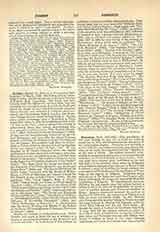

Formby, HENRY, b. 1816; d. at Normanton Hall, Leicester, March 12, 1884. His father, Henry Grenehalgh Formby, was the second son of Richard Formby of Formby Hall, Lancashire. The family had been Catholic until the eighteenth century, when, with the exception of a younger branch, they lost the Faith and closed the chapel of their fifteenth-century mansion. Henry Formby was educated at Clitheroe grammar-school, the Charterhouse School, London, and Brasenose College, Oxford, where he took his M.A. Having taken orders, he became vicar of Ruardean in Gloucestershire, where in 1843 he completed his first book, “A Visit to the East”, and he showed the interest in ecclesiastical music that always characterized him in a pamphlet reprinted from “The English Churchman” called “Parochial Psalmody Considered” (1845). At this time he was profoundly influenced by the Oxford Movement, and soon after his friend Newman became a Catholic, he decided to resign his living and join the Church. His reception took place on January 24, 1846, at Oscott, where he continued studying theology till he was ordained priest, September 18, 1847. He was attached to St. Chad’s Cathedral where the careful performance of plain chant has ever been a noted feature of the services, and while there he published three works on the subject: “The Catholic Christian‘s Guide to the Right Use of Christian Psalmody of the Psalter” (1847); “The Plain Chant the Image and Symbol of the Humanity of the Divine Redeemer and the Blessed Virgin Mary” (1848); and “The Roman Ritual and Its Canto Fermo, Compared with the Works of Modern Music, in Point of Efficiency and General Fitness for the Purpose of the Catholic Church” (1849). He also published “The Young Singer’s Book of Songs” (1852), “School Songs and Poetry to Which Music Is Adapted” (1852), and he was one of the editors of the “First Series of Hymns and Songs for the Use of Catholic Schools and Families” (1853) Other works belonging to this period were: “The Duties and Happiness of Domestic Service” (1851), “The March of Intellect; or, The Alleged Hostility of the Catholic Church to the Diffusion of Knowledge Examined” (1852), and “State Nationalism in Education; An Examination into the Actual Working and Results of the System of the Board of Commissioners of National Education in Ireland” (1854).
Besides his interest in ecclesiastical music, Father Formby had much at heart the use of pictures as a means of spreading knowledge of the Scriptures and Catholic doctrine. In furtherance of this purpose he published a series of carefully illustrated books. Chief among these was his very successful “Pictorial Bible and Church History Stories”, which began with “Pictorial Bible Stories for the Young” (1856). An edition of the complete work was published in 1857, followed by another in three volumes with new illustrations in 1862, and an abridged one-volume edition in 1871. From 1857 to 1864 he took charge of the mission at Wednesbury; during which time he published “The Fifteen Mysteries of the Rosary” (1857), “The Life of St. Benedict” (1858), “The Parables of Our Lord Jesus Christ” (1858),”The Life of St. Patrick” (1862), all of which were illustrated. A sermon on “Our Lady of Salette” (1857) and “The Inquiry of a Retired Citizen into the Truth of the Catholic Religion” (1863) were also published while he was at Wednesbury. In 1864 he retired from active missionary work and withdrew to the Dominican priory at Hinckley in Leicestershire, where he spent the remaining twenty years of his life in issuing books and pamphlets and in helping to train the novices. For some years he edited “The Monthly Magazine of the Holy Rosary“. His later publications included “The Cause of Poor Catholic Emigrants Pleaded” (1867); “Fleury’s Historical Catechism continued to the Vatican Council” (1871); “The Book of the Holy Rosary” (1872); “De Annis Christi Tractatus” (1872); “Sacrum Septenarium” (1874); “The Children’s Forget-me-not” (1877); “Compendium of the Philosophy of Ancient History”; “Little Book of the Martyrs of the City of Rome” (1877); “Five Lectures on the City of Rome” (1877); “Monotheism … the primitive Religion of the City of Rome” (1877); “Ancient Rome and Its Connection with Christian Religion” (Part I, 1880; Part II, unfinished at his death); “The Growing Unbelief of the Educated Classes” (1880); “Safeguards of Divine Faith in the Presence of Sceptics, Atheists, and Free-thinkers” (1882); “A Familiar Study of the Sacred Scripture“, his last work. He also wrote a great number of minor devotional and educational books.
EDWIN BURTON

